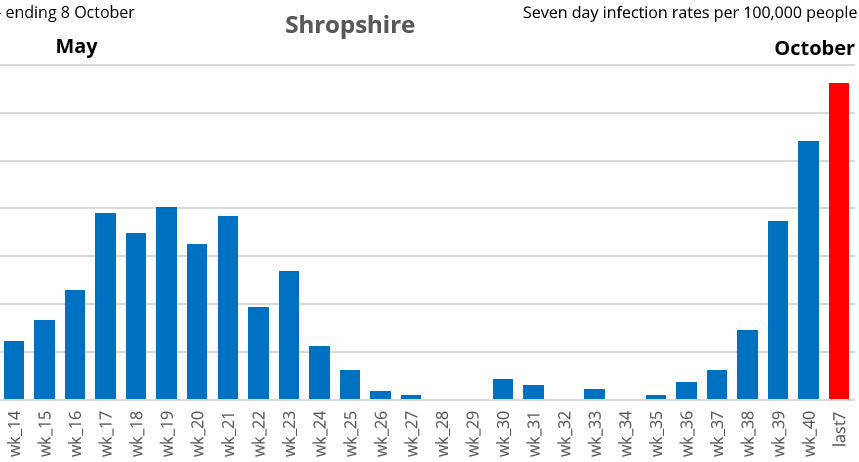The government is to introduce a three tier scheme for controlling the spread of coronavirus. Despite some reports on local media yesterday morning, Shropshire and Telford and Wrekin are at the lowest tier, the medium alert level. That means no change to restrictions from now. The rule of six will still apply and pubs will close at 10pm as now.
During the last few weeks, the infection rate in the Shropshire unitary area has grown from 14 cases to 66 cases per 100,000 people over seven days. If the rate continues to increase in the next few weeks, we are likely to be pushed into the second tier, high alert level. That will outlaw all mixing indoors between different households or support bubbles, Outdoors, in public spaces and private gardens the rule of six will apply. Although people are getting tired of restrictions, we need to continue to take care.
Boris Johnson’s announcements yesterday brought some clarity to the increasingly complex mosaic of restrictions across England. Wales, Scotland and Northern Ireland have their own rules.
Under the new rules, Liverpool gets hit the hardest, with severe third tier restrictions. The city region has seen infection rates of more than 600 cases per 100,000 people in some areas over the last seven days. Its pubs and clubs will close on Wednesday, along with a range of other restrictions. Our near neighbours, Cheshire East and Cheshire West, along with the High Peak, are seeing infection rates of around 150-170 and will go into the second tier as will all areas that currently have additional local restrictions. Those areas include Wolverhampton. Birmingham and Manchester (full list; BBC map). Across the border in Wales, much of the south is in local lockdown including Cardiff, Newport and Swansea as is much of north Wales.
With infection rates rising, it is possible that other areas will be brought into tier two and tier three restrictions. And it is clear that the government’s scientific advisers think ministers are doing too little too late. England’s Chief Medical Officer hardly sounded enthusiastic at the Downing Street briefing last night. Chris Whitty was talking about Tier Three but no one would be suprised if additional restrictions are added to lower tiers.
Although there is no local impact on Ludlow and Shropshire, the restrictions reinforce the message of keep local, shop local. That will also help our local businesses survive challenging times.
With the weather currently predicted to get colder in November, it could be a long winter ahead. That means we all need to support each other. We have shown that we can do this in Ludlow over many years and especially during the pandemic.
The rules for Ludlow, Shropshire and Telford and Wrekin (Tier One, medium alert)
Full list of restrictions by tier.
- No socialising in groups larger than 6, indoors or outdoors (other than where a legal exemption applies to the rule of 6).
- Businesses and venues can continue to operate in a COVID-secure manner.
- Pubs and bars ensure customers only consume food and drink while seated, and must close between 10pm and 5am.
- Businesses and venues selling food for consumption off the premises can continue to do so after 10pm if through delivery service, click-and-collect or drive-through.
- Schools and universities remain open.
- Places of worship remain open, subject to the rule of 6.
- Weddings are capped at 15 people and funerals at 30.
- Exercise classes and organised sport can to take place outdoors – indoors if the rule of 6 is followed.
- Face coverings in those areas where this is mandated – all enclosed areas where the public can enter including public transport and taxis.
The government advises you should continue to follow social distancing rules and work from home where you can effectively do so. It asks people to plan ahead when travelling, plan and avoid busy times and routes. Walk or cycle if you can.
Infection rates per 100,000 people up to 8 October
The red bar shows the last seven days for which data is available. In these graphs, that overlaps with data for Week 40 which ended on 4 October. Data is now published daily.




